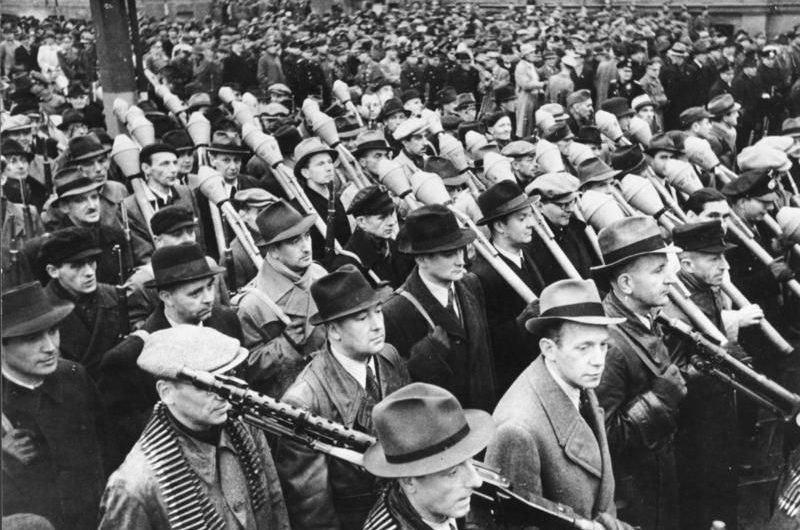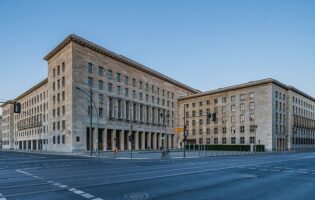
Bundesarchiv Bild 146-1971-033-15 via Wikimedia Commons
Education for Boys

Kevin Ostoyich
Valparaiso University
Prof. Kevin Ostoyich was a Visiting Fellow at AICGS in summer 2018 and was previously a Visiting Fellow at AICGS in summer 2017. He is Professor of History at Valparaiso University, where he served as the chair of the history department from 2015 to 2019. He holds his B.A. from the University of Pennsylvania and his A.M. and Ph.D. from Harvard University. Prior to moving to Valparaiso, he taught at the University of Montana. He has served as a Research Associate at the Harvard Business School and an Erasmus Fellow at the University of Notre Dame. He currently is an associate of the Center for East Asian Studies of the University of Chicago, a board member of the Sino-Judaic Institute, and an inaugural member of the Shanghai Jewish Refugees Museum International Advisory Board. He has published on German migration, German-American history, and the history of the Shanghai Jews.
While at AICGS, Prof. Ostoyich conducted research on his project, “The Wounds of History, the Wounds of Today: The Shanghai Jews and the Morality of Refugee Crises.” The Shanghai Jews were refugees from Nazi Europe who found haven in Shanghai, and thus escaped the Holocaust. For this project Ostoyich has interviewed many former Shanghai Jewish refugees and has conducted research at the National Archives at College Park, MD, and United States Holocaust Memorial Museum. At Valparaiso University he co-teaches a course titled “Historical Theatre: The Shanghai Jews,” which fuses the disciplines of history and theatre. To date, students of the course have co-written and performed two original productions based on the history of the Shanghai Jewish refugee community: Knocking on the Doors of History: The Shanghai Jews and Shanghai Carousel: What Tomorrow Will Be. In addition to his work on the Shanghai Jews, he is currently working on projects pertaining to the experiences of ordinary Germans during the bombing of Bremen, German Catholic experiences in nineteenth-century Württemberg, German Catholic migration, and U.S.-German cultural diplomacy during the first half of the twentieth century.
Click here for an article by Ostoyich on the Shanghai Jews.
He is currently trying to interview as many former Shanghailanders as possible. If you would like to be interviewed or know someone who might want to be interviewed, please contact Professor Ostoyich at kevin.ostoyich@valpo.edu.
Part Two of Rubble Child’s World: Stories from Bremen’s Ruins
Introduction
Rand Paul was frustrated. During a hearing of the Senate Health, Education, Labor, and Pensions Committee, the Republican Senator from Kentucky asked Dr. Anthony Fauci, “When are we going to tell the people the truth, that it’s OK to bring our kids to school?”[1] The COVID-19 crisis has interrupted and altered child schooling all over the world. But as children have been kept from school, they have been gaining a different kind of education. As the crisis has worn on, it has been increasingly difficult to shield children from the grim realities of the outside world. They are witnessing unemployment, uncertainty, sickness, racism, and death—death on an unimaginable scale. On May 8, 2020, the attention of adults and children the world over was on the COVID-19 crisis. Understandably so. But that date warrants our attention, for it was the 75th Anniversary of VE Day. Seventy-five years ago, schools throughout Germany were closed too due to a virus—the virus of hate. With schools not only shut down, but blown to bits by Allied bombs, the children of Bremen experienced a different kind of education. Here is what two ordinary German boys learned at that time.[2]
Boy #1: School Essay: My Life Since the Exit from School[3]
Whoever has traveled a lot and has experienced a lot, can tell a lot. That is a well-known truth. Hence, a schoolboy, who was in the Wehrmacht for quite some time, will be able to recount a great many experiences. I only left school at the beginning of this year and can only provide the little episode of my deployment in the Volkssturm in the forefront of my life since the exit from school. But this will always remain particularly in my memory, given that it transpired in the immediate vicinity of my hometown of Bremen and reached into its capture.
It was a few weeks before the occupation of Bremen by the Allied troops, when I was called up for duty in the Volkssturm. I entered one of the five companies constituted in Bremen, which were assembled from teenagers from 15 to 18 years and led by members of the Wehrmacht. We from the first company were barracked in the former technical aviation school in Bremen-Osterholz. We liked it there very much. We were trained militarily, sometimes though, incompletely. The anti-tank rocket launcher was dealt with especially thoroughly though, given our actual task was supposed to be the destruction of tanks. Infantry deployment was not supposed to be performed by our company. We were only very modestly armed with weapons. The motto went “Get them yourselves,” which we adhered to with pleasure. Actually, we were able to get hold of a cache of weapons out of the OT camp [Officer Candidate Camp] and anti-aircraft batteries, so that then the majority of the company possessed anti-tank rocket launchers and the others were furnished with carbines, hand grenades, and a few submachine guns. So armed we looked ahead with great illusions.
Meanwhile, Bremen’s situation had come to a crisis. To the south at Huchting there was fighting, to the southwest at Delmenhorst as well, and to the southeast the English stood at Achim. The population was kept constantly in check by the daily bombings and unpredictable artillery fire and spent most of the time in air-raid shelters. The artillery barrages made an unpleasant impact by us as well, and more than once we took full cover. Otherwise, though, we were little disturbed by this, and during the air-raid alarms we mostly lay in the grass and let the April sun shine on us.
On April 22, a Sunday, the message suddenly came through that British tanks had appeared near Oyten. Concurrently, there was a deployment order for the first and second platoon (I belonged to the third platoon; there was also a fourth platoon as well). These two platoons mounted the bicycles that stood at the company’s disposal, and rode away in the direction of Oyten—leaving behind the rest of us with mixed feelings. They came back late at night. They had been withdrawn because it proved impossible to attack the tanks. Aside from these, the English had already allocated a great mass of infantry and artillery. The next day we German troops could observe those being deployed in the area of Tenever. It was clear to us that it was now going to be serious.
It was clear to us that it was now going to be serious.
In the early morning of the 24th of April, the staff of an engineer battalion set up its command post in our building. This battalion was positioned approximately on the line between Tenever and Mahndorf. In the afternoon the order came for us to set up a strong security post at the Hemelingen German State Railroad Repair Workshop. It was, again, the first and second platoon that had to carry out this assignment. Arbergen in the meantime had been occupied by Tommy, and a platoon leader reported with a laugh from Hemelingen how he had observed with binoculars a few tall Englishmen, who were milling about in Arbergen. Toward evening a barrage of heavy artillery commenced, and we had to go into the cellar of the building. The direct attack on Bremen had begun.
It was 11 o’clock in the evening. The artillery fire had intensified. Our building sustained a few hits. A nervous tension reigned in the cellar. Everyone awaited further orders. Parts of the first and second platoon positioned in Hemelingen came back. They reported that the Brit had just broken through toward Sebaldsbrück at the place where they had positioned. They had not been able to stop him. The platoon leader had given the order to retreat. A part was still scattered. As we later found out, five comrades had died. They lay buried in the Osterholz Cemetery.
We looked out and noticed from the flaming tracer bullets that to our right the battle was already unfolding in Sebaldsbrück, before us the enemy advanced ever closer, and it was also noticeable to our left in Tenever. If we did not wish to be trapped, only the path toward Oberneuland remained open. This we pursued then at one o’clock in the morning upon the order of the company leader. Except for our weapons, all equipment was left behind. We reached the freeway fairly unscathed, where we were greeted by a hellish anti-tank fire, which, as it later turned out, came from a German battery, which had no idea where friend or foe were. Fortunately, we had not sustained any casualties. We then moved on via Oberneuland to Borgfeld, where we spent the rest of the night. It was a sad march that lay behind us. But it would have been madness, with the little guys among us, to engage with the enemy at all, especially given we were supposed to avoid infantry deployment. Thus, the operation had gone entirely different than we had imagined. Our morale was unbroken though.
In the next days all the German troops located in the vicinity of Bremen fell back to Borgfeld. The last brought the news that the city had been surrendered. We marched then, partly under contact with the enemy, via Lilienthal and Worpswede to the area of Osterholz-Scharmbeck, where the company was disbanded. We now beat our way to Bremen in quickly-obtained civilian clothes, although a small part was still attacked and taken prisoner. But this too got back home intact in the meantime.
The time in Bremen after the occupation was extremely monotonous and depressing.
The time in Bremen after the occupation was extremely monotonous and depressing. Everybody probably felt this way. But slowly a revival became noticeable, and public life began to pulsate again in the usual way. But now a new era has dawned with new ideas and forms. New things have come to us and play a roll. Only the future will show what the new brings and whether it will prove successful.
During the summer months, I worked in a commercial firm, in which I gained insight into the commercial business and received the corresponding knowledge. I was entrusted with things that could be very useful to me for my later career. Now I am again back here, where I sat nine months ago: upon the school bench. And I am happy that it is possible for me to once again attend regular school lessons; because in the last years of the war, we students, indeed, due to the circumstances, did not learn so much as would normally have been the case. And I hope, then, in the year after next, to be able to successfully take the school-leaving examination.
Boy #2: Recollection of a Fourteen-Year-Old Boy[4]
We spent the last weeks before the end of the war predominantly in the air-raid bunker on the Burgdammer Ring in the city district of Burglesum. We hardly knew whether we had pre-alarm or full alarm. Still today we have not heard the sound of the all-clear signal. During these fearful weeks, we were hardly able to change clothes. We only occasionally visited our house in order to undergo a bodily cleansing. Later, the strafers and the barrage of shells completely prevented us from leaving the bunker.
We “celebrated” my confirmation on March 18, 1945. On account of the alarm-threats, we were confirmed quite early in the morning on this Sunday in the St. Martin’s Church in Lesum. Immediately after the confirmation we received an air-raid warning, so we had to hurry to our usual place in the air-raid bunker. In the afternoon there was just enough time to consume my mother’s homemade beechnut cake and drink a glass of “hot beverage” to my health until the air-raid sirens called us back into the bunker.
So passed perilous hours, days, and weeks. On April 1, 1945, I had to report for my duty as public administration apprentice at the “Burglesum Office” (today Burglesum Local Authority) in Bremen-Lesum on Hindenburgstrasse. Thus, I had no more occasion to pay attention to the air-raid sirens. It was for me more than self-evident that I had to perform my duty irrespective of any external influences. On a gorgeous spring day, I started to cycle toward the “office.” As noted, it was the 1st of April!! My father, in the meantime, had converted my school bag into a “briefcase.”
My father, in the meantime, had converted my school bag into a “briefcase.”
After I had parked my bicycle in the bicycle shed, I proceeded through the back entrance to the office building, where my boss crossed my path. Appropriate to my upbringing in my parents’ house, I politely greeted him with “Good morning.” My boss’ reaction was bewildering and incomprehensible to me; he answered me with the following: “That is not good morning, that is Heil Hitler!”
Some fourteen days later, I greeted him, certainly driven by the devil, with Heil Hitler. Thereupon my boss responded: “Shut your mouth, that is good morning!” I should note that my boss at the time was at wit’s end. This little, amusing episode has remained for me a vivid memory in my forty-year period of service.
My first work station had a nostalgic character […].[5]
I was […] equipped with an air-raid helmet and a gas mask. The air-raid helmet all but took away my sight, it came down over my ears. It should be noted that we now had to go more and more to the air-raid shelter in the office building. My boss became ever more nervous. The general situation changed day by day.
Already on April 7, 1945, British tanks stood some fifteen kilometers in front of our city. On April 10, 1945, the artillery bombardment commenced on Bremen, which fell on the 25th and 26th of April 1945 after heavy fighting.
On April 27, 1945, English troops occupied the city districts of Grambke, Burg, and Grambkermoor. After the demolition of the Lesum Bridge on the same day, the high bank of the Lesum became the main battle front, which was given up without a fight.
My first apprenticeship assignment in the postwar period consisted of removing the swastika emblems.
Immediately after the surrender, the first occupying soldiers—they were English—appeared in our offices as well. With weapons over their shoulders, they stood before my writing desk and made a rather awkward impression, especially given they were not proficient in German. Very soon it was clear to us that the visit was not for us but for the “SA – Unit 19” (SA = Storm Detachment), which had its offices upstairs in the same house. The aforementioned occupying soldiers looked around in these SA offices very thoroughly—and took apart everything that was not nailed down. Later we inspected these office rooms and secured everything that was of value, especially the office machines. My first apprenticeship assignment in the postwar period consisted of removing the swastika emblems. I had received the task of getting rid of all the swastikas from the official seals. With a sharp pocketknife, I got to work and performed the “amputations.” They looked really bare and defaced, these “beautiful” official seals. Adolf Hitler, the ruler and dictator of the “Third Reich,” had written the book “Mein Kampf” during his time of imprisonment. Young married couples received a clothbound edition of this book on the day of their civil marriage from the registrar after the marriage ceremony. We still had a number of these books in stock. Naturally, these books ought or had to be destroyed, although they soon became enormously valuable. Notwithstanding this, I had excavated a pit, in order to bury these “Mein Kampf” books. Whether these books really found their final rest, though, I daresay is doubtful. It cannot be entirely ruled out that these books were brought back into the light of day by unauthorized parties.
Such are my memories from a time that dates back nearly fifty years.
It remains to be noted that I was allowed to serve my “Office,” respectively later, the Local Authority, for forty years.
Conclusion
When the time comes—and hopefully that time is soon—when children around the world return to their “school benches,” will they resume their traditional studies? One wonders the degree to which the things they have learned during the COVID crisis will continue to structure their education and lives. Will they write essays about “What I did during the COVID crisis?” Will lessons they have learned while being sheltered in place simply just get packed away in some locker and they move along as if nothing happened? In the accounts of the Volkssturm boy and the administrative apprentice there are definite indications of moving on with one’s life—whether it be to resume preparation for an exit exam or work at a reopened (and renamed) office. But how easy is it simply to move on after one learns how to use an anti-tank rocket launcher or is ordered to ride one’s bicycle to the front?
The juxtaposition of schools and symbols of hate in the two accounts seems particularly striking for present-day issues in the United States. As children peer outside from their sheltered existence they are confronted with a country undergoing a reckoning with entrenched symbols of hate. Statues, still referred to as “beautiful” by many, were erected in order to perpetuate Jim Crow discrimination toward a racial minority. As the country currently conducts its own “amputations” of these symbols from its seals—such as the recent action of the state of Mississippi to remove the Confederate battle emblem from its flag—one wonders the extent to which schoolboys and schoolgirls will retain the lesson. As public life begins “to pulsate again,” will the “new ideas and forms” take hold? Or will symbols of hatred be “brought back into the light of day by unauthorized parties”? As the country painfully emerges into a “new era” in which systemic racism is exposed, “only the future will show what the new brings and whether it will prove successful.”
Kevin Ostoyich dedicates this article to the memory of his grandfathers, George H. Jordan, Jr. (January 5, 1918 – July 11, 1994) and Steven M. Ostoyich (June 21, 1921 – February 7, 2009), both of whom fought for the U.S. Army during the Second World War.
Kevin Ostoyich wishes to thank Marion Alpert and all the wonderful archivists and staff members at the Staatsarchiv Bremen for being so welcoming and helpful over the years and Dean Jon T. Kilpinen of the College of Arts and Sciences at Valparaiso University for his ongoing support.
The research for the “Rubble Child’s World: Stories from Bremen’s Ruins” series was conducted while Kevin Ostoyich was a guest professor at Reutlingen University. He wishes to thank Regine Lechler-Fiola, Richard Schilling, and Baldur Veit for their friendship and support.
The texts in this article were translated from the original German by the author.
[1] For an account of the exchange between Paul and Fauci, see https://thehill.com/homenews/senate/505302-rand-paul-urges-fauci-to-provide-more-optimism-on-coronavirus (Accessed July 1, 2020).
[2] The two accounts presented here were submitted in response to a call from the Bürgermeister of Bremen in 1994 for the citizens of the city to send in materials pertaining to the end of the Second World War in preparation for the 50th Anniversary of VE Day in 1995. Over 100 individuals sent in materials, which are presently housed in the State Archives of Bremen (Staatsarchiv Bremen). The archival reference number for the collection is 9, S 9-25.
[3] This contribution is a school essay a boy wrote in December 1945 after having served in the Volkssturm (the civil defense that was formed throughout Germany beginning in October 1944 and generally consisted of males between the ages of 16 and 60) The author notes that starting age for members of the Volkssturm in Bremen was 15. Note: The identity of each individual has been withheld.
[4] Decades after the end of the Second World War, the author of this account looked back on his childhood and provided the title “Recollections of a Fourteen-Year-Old Boy.”
[5] He describes his work station at length.








